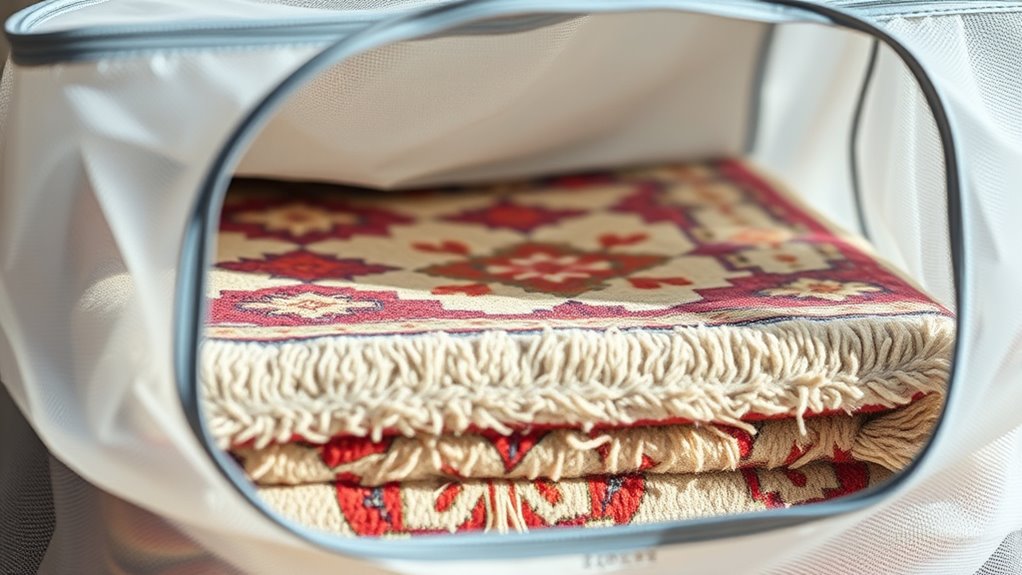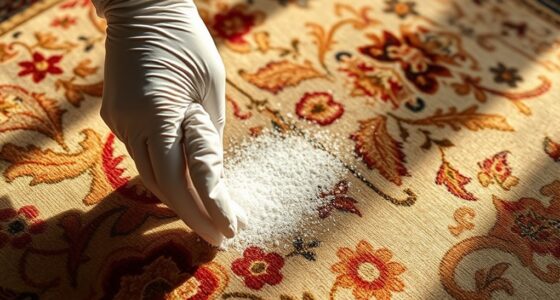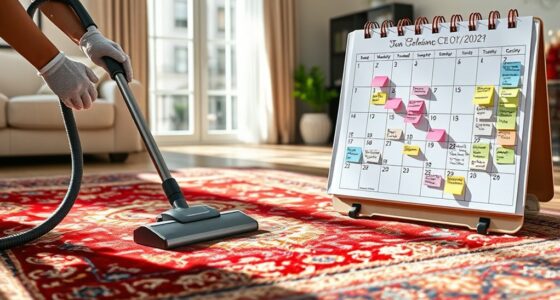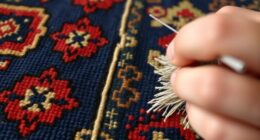When storing seasonal rugs, choosing breathable bags like cotton canvas, linen, or mesh fabric allows moisture to escape, preventing mold and keeping fibers intact. Avoid plastic containers, which trap humidity and can damage your rugs. Make sure the rug is clean and completely dry before packing, then carefully fold or roll it to prevent fibers from tearing. If you keep exploring, you’ll discover more tips to keep your rugs safe and pristine during storage.
Key Takeaways
- Choose breathable materials like cotton, linen, or linen-cotton blends for storage bags to promote airflow and prevent moisture buildup.
- Use mesh fabric or canvas bags designed specifically for textiles to ensure proper ventilation and protection.
- Properly clean and thoroughly dry rugs before storing them in breathable bags to avoid mold and mildew.
- Label and organize seasonal rugs with color-coded tags for easy identification and efficient storage management.
- Avoid plastic containers; opt for fabric or natural fiber bags that allow moisture escape and safeguard rug fibers.
Benefits of Using Breathable Bags for Rug Storage
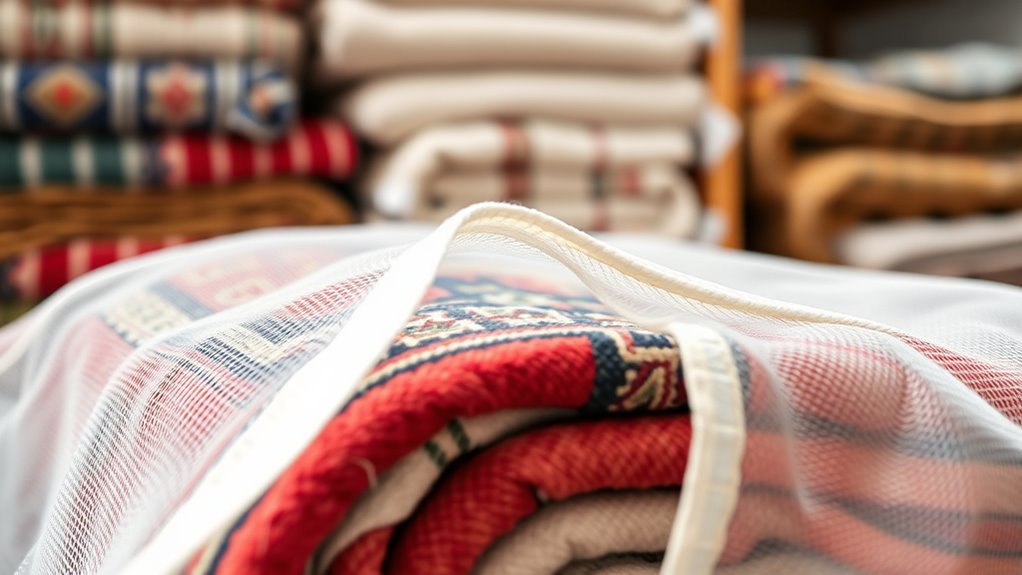
Using breathable bags for rug storage offers several advantages that help protect your rugs during the off-season. These bags maintain a stable indoor climate by allowing moisture to escape, preventing mold and mildew growth. This breathability also helps keep the rug dry and odor-free, preserving its appearance and freshness. Additionally, breathable bags act as a barrier against pests like moths and carpet beetles, reducing the risk of infestations. Unlike plastic alternatives that trap humidity and create a breeding ground for pests, these bags promote airflow, safeguarding your rugs’ fibers and colors. Proper ventilation is essential for maintaining optimal conditions during storage. By choosing breathable storage, you ensure your rugs stay in excellent condition until you need them again, making seasonal storage easier and more effective. Moreover, selecting the right rug storage options can further enhance protection and longevity. Proper storage methods can also prevent dust accumulation and environmental damage, extending the life of your rugs. For optimal results, consider using breathable storage bags designed specifically for delicate textiles, which combine breathability with durability.
Types of Breathable Storage Bags Suitable for Rugs
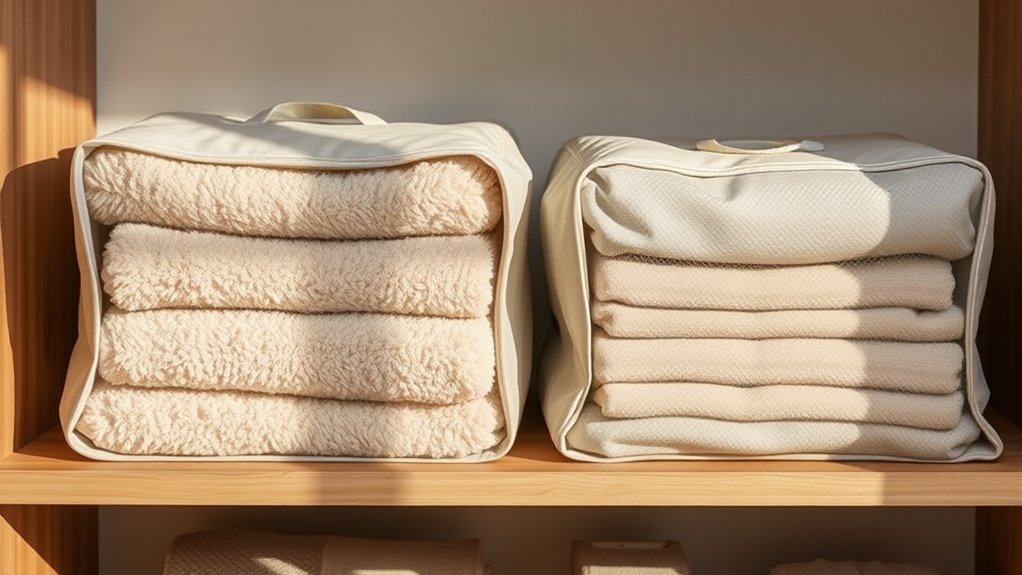
When choosing breathable storage bags for your rugs, you’ll find options like mesh fabric bags, cotton canvas covers, and linen solutions. Each type offers unique benefits, from airflow to durability, making them suitable for different needs. Understanding these options helps you select the best storage method to keep your rugs fresh. Additionally, selecting a general ledger coding system can enhance your inventory management and ensure proper record-keeping of stored items. Incorporating climate control features in storage solutions can further protect your rugs from humidity and pests, ensuring longevity and quality. Proper ventilation is essential to prevent mold and mustiness, especially in humid environments, which aligns with the importance of airflow for preserving your rugs.
Mesh Fabric Bags
Mesh fabric bags are an excellent choice for storing rugs because they allow air to circulate freely, preventing moisture buildup and mold growth. Made from synthetic fibers, these bags are lightweight, durable, and resistant to tearing, making them ideal for seasonal storage. Unlike plastic containers, mesh bags don’t trap humidity, which helps keep your rugs fresh and free from musty odors. They offer visibility so you can easily identify your rug without opening the bag, saving you time. Mesh fabric also dries quickly if any moisture gets in, reducing the risk of mold. While plastic containers may be airtight, they can trap moisture and lead to mildew. Mesh bags provide a breathable, practical solution for protecting your rugs during off-season storage. Additionally, mesh fabric bags are often used in skincare routines like eye patches to allow for proper airflow and prevent irritation. Their breathability aligns with ventilation principles, ensuring your stored items remain in good condition.
Cotton Canvas Covers
Cotton canvas covers are a popular choice for storing rugs because they are highly breathable, helping to prevent moisture buildup and mold growth. Made from natural fibers, they allow air circulation while protecting your rug from dust and pests. Unlike synthetic fibers, cotton canvas is eco-friendly and durable, making it ideal for long-term storage. You can also add decorative accents, such as embroidery or contrasting trims, to personalize your storage solution. These covers are sturdy yet flexible, ensuring your rug stays in good condition without compression. Plus, they’re easy to fold and store when not in use. Overall, cotton canvas covers combine practicality with aesthetic appeal, making them a reliable option for seasonal rug storage.
Linen Storage Solutions
Linen storage solutions are an excellent choice for protecting your rugs while allowing proper airflow. Linen bags prevent moisture buildup, reducing mold risk and maintaining your rug’s vibrant colors. They also serve as decorative rug accents, blending seamlessly into your storage space. When choosing a linen bag, consider size, breathability, and durability. To keep your rug in top shape, follow rug cleaning tips before storage, ensuring it’s clean and dry. Using the table below to compare different linen storage options can help you make an informed decision:
| Feature | Benefits | Ideal For |
|---|---|---|
| Natural Linen Bags | Breathable, eco-friendly, stylish | Seasonal storage |
| Linen-Cotton Blends | Increased durability, aesthetic appeal | Long-term storage |
| Decorative Linen Bags | Adds charm, often decorative patterns | Displayed storage |
| Heavy-Duty Linen Bags | Extra protection, sturdy construction | Heavy rugs |
Additionally, selecting breathable fabrics can help prevent moisture accumulation and prolong the lifespan of your stored rugs. Proper storage conditions are also essential to maintain your rug’s quality over time. Using ventilated storage options can further improve airflow and help keep your rugs fresh. Implementing appropriate ventilation is crucial to avoid mustiness and preserve rug integrity during storage.
Materials to Look for in Rug Storage Bags
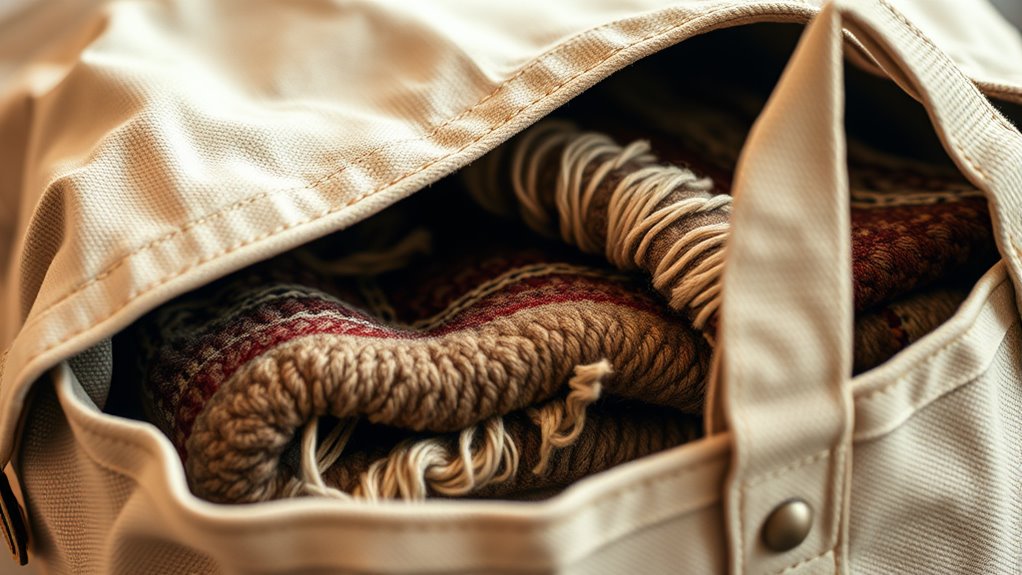
When choosing rug storage bags, it’s essential to look for materials that protect your rug without causing damage. First, opt for breathable fabrics like cotton or linen, which allow air circulation and prevent mold. Second, consider fabric durability—sturdy materials like canvas or heavy-duty polyester resist tears and wear over time. Third, think about aesthetic appeal; attractive, well-made bags add a neat look to your storage space. These materials help maintain your rug’s condition and preserve its appearance. Avoid plastic bags, as they trap moisture and can damage delicate fibers. Additionally, selecting appropriate storage conditions that control humidity and temperature further safeguards your rug’s integrity. Using breathable fabrics can significantly reduce the risk of mold and mildew growth during storage. Proper storage techniques, including correct bag choice, are essential for prolonging the life of your rug and keeping it in excellent condition. By selecting bags made from breathable, durable, and visually appealing fabrics, you ensure your rug stays safe, clean, and ready for use when the season changes.
How to Properly Prepare Rugs Before Storing

Before storing your rug, taking the time to give it a thorough cleaning and proper preparation is vital to prevent damage and maintain its appearance. Start with rug cleaning techniques like vacuuming both sides to remove dirt and dust. For stubborn stains, use specific stain removal tips suited to your rug’s material, such as gentle spot cleaning with mild detergents or vinegar solutions. Make sure your rug is completely dry before packing to prevent mold and mildew growth. Check for any damage or loose fibers and repair them if needed. Removing debris, dirt, and stains ensures your rug stays fresh and in good shape during storage. Proper preparation helps preserve colors, fibers, and overall quality, making sure your rug looks its best when you take it out again. Additionally, consider GMC tuning options to enhance your vehicle’s performance during seasonal changes, ensuring optimal functionality when you need it most. Incorporating proper storage containers can also provide extra protection from pests and environmental elements, extending the life of your rug. To further protect your rug, applying essential oils for stain prevention may help keep it fresh and resistant to odors during storage. Recognizing the importance of Kia Tuning can also be beneficial if you want to keep your vehicle in top condition throughout the year.
Step-by-Step Guide to Packing Rugs in Breathable Bags
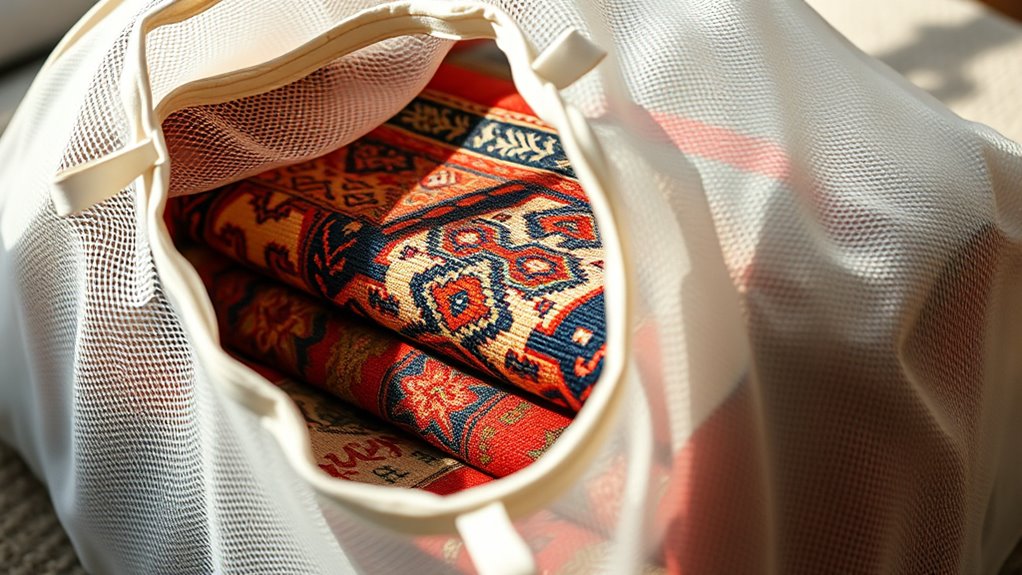
After thoroughly cleaning and inspecting your rug, the next step is packing it properly to protect it during storage. Using breathable bags helps prevent mold and odors while keeping your rug safe. Here’s a simple guide:
Properly packing your rug with breathable bags keeps it fresh and protected during storage.
- Fold or roll your rug carefully, avoiding creases that could damage fibers. Use gentle cleaning techniques to remove dust and dirt beforehand. Proper storage techniques are essential to preserving your rug’s condition over time. Additionally, understanding the weight of your rug can influence how you handle and store it safely.
- Place the rug into a breathable bag, ensuring it’s not squeezed tight. Consider decorating ideas like adding a soft cloth inside to cushion and prevent wrinkles.
- Seal the bag loosely, allowing airflow to prevent moisture buildup. Store in a cool, dry spot away from sunlight to maintain its colors and quality.
- Being aware of the weight of your rug is essential for safe handling and transportation, especially for larger or heavier pieces.
Follow these steps to ensure your rug stays fresh and ready for use when the season changes.
Tips for Labeling and Organizing Seasonal Rugs
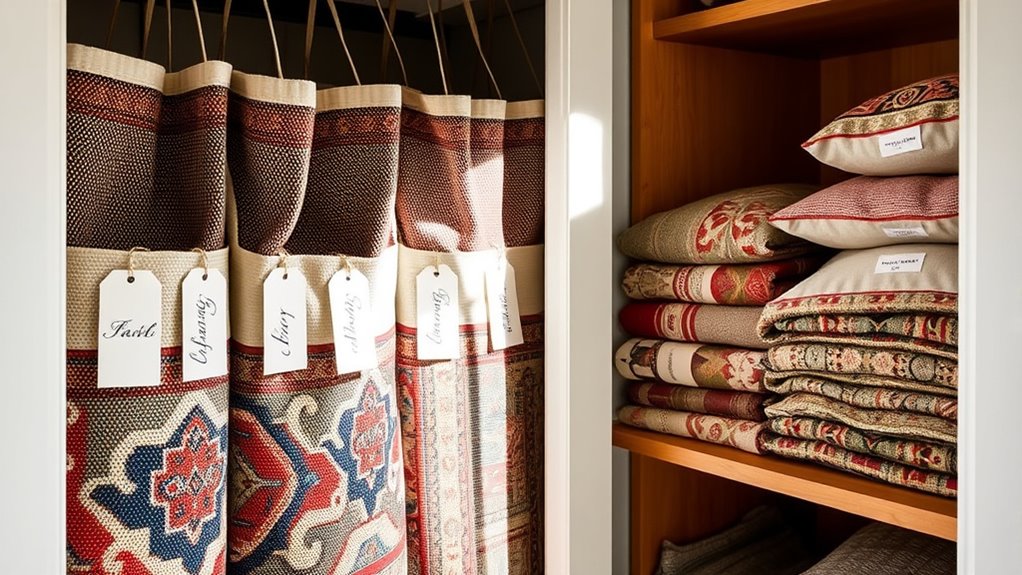
Organizing and labeling your seasonal rugs guarantees you can easily find the right one when the time comes to switch them out. Use decorative rug labels to clearly identify each rug’s season and style. Color coding techniques help differentiate between winter, spring, summer, and fall rugs at a glance. Consider assigning specific colors to each season, like blue for winter or yellow for summer, and applying these to your labels and storage bags.
| Season | Color | Label Type |
|---|---|---|
| Winter | Blue | Decorative Rug Label |
| Spring | Green | Decorative Rug Label |
| Summer | Yellow | Decorative Rug Label |
| Fall | Orange | Decorative Rug Label |
| All Year | Gray | Decorative Rug Label |
This system simplifies retrieval, maintains organization, and guarantees your rugs stay in top condition.
Common Mistakes to Avoid When Storing Rugs
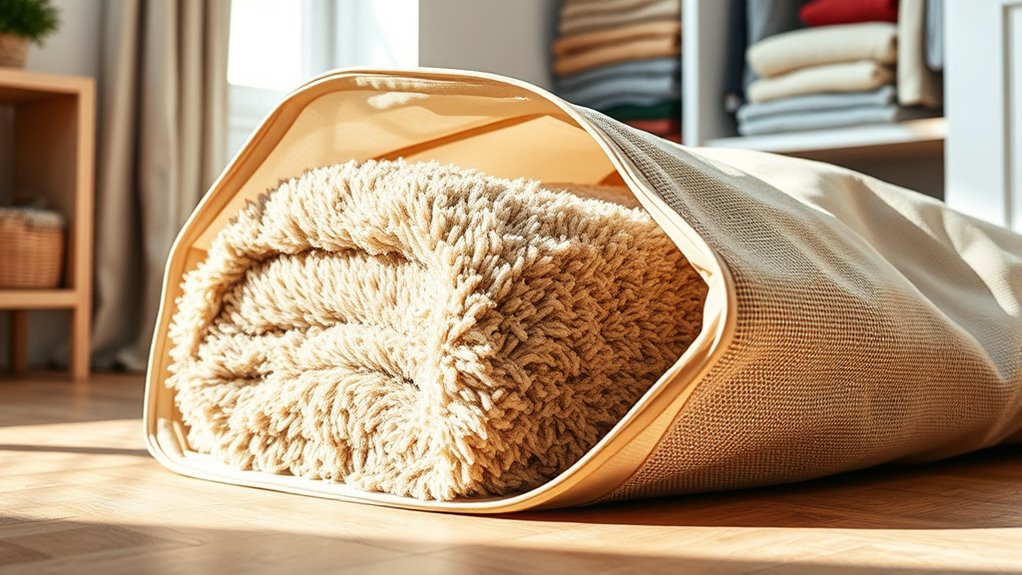
One common mistake is failing to guarantee proper ventilation, which can trap moisture and cause mold or mildew. Using non-breathable storage materials like plastic can also trap humidity and damage your rug over time. Avoid these pitfalls to keep your rugs in good condition throughout the season.
Improper Ventilation Practices
Are you ensuring your rug has proper airflow during storage? Improper ventilation can lead to mold, mildew, and musty odors. To avoid this, steer clear of these common mistakes:
- Storing rugs in plastic containers without vents, trapping moisture inside.
- Using synthetic fabrics that don’t breathe, which can trap heat and humidity.
- Wrapping rugs tightly in plastic or non-breathable covers, preventing airflow and causing damage.
Instead, opt for breathable storage options like fabric bags or storage bins with ventilation. Always allow air circulation around your rug and avoid sealing it completely. Proper ventilation keeps your rug dry, fresh, and protected from moisture-related issues, ensuring it stays in great condition for seasons to come.
Using Non-Breathable Materials
Using non-breathable materials when storing your rug can cause serious damage over time. Synthetic fibers in plastic containers trap moisture, creating a damp environment that encourages mold and mildew growth. These materials prevent airflow, which is essential for keeping your rug dry and free from musty odors. Storing your rug in plastic containers might seem convenient, but it can lead to irreversible damage. Instead, opt for breathable storage options that allow air circulation. Avoid wrapping your rug tightly in non-breathable materials, as this can cause discoloration and deterioration. Always choose storage solutions that promote ventilation to preserve your rug’s quality and appearance. Proper storage not only protects your investment but also ensures your rug remains fresh and in good condition for seasons to come.
Maintaining and Inspecting Stored Rugs Periodically
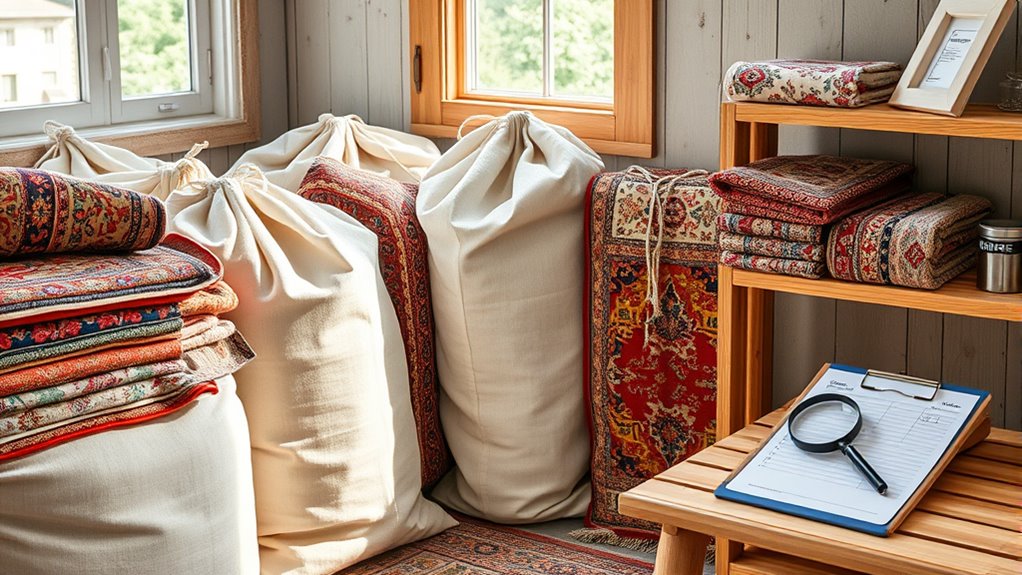
Regularly inspecting your stored rugs is essential to keep them in good condition. This helps you catch issues early and maintain their appearance. Focus on three key areas:
Regularly inspecting stored rugs helps prevent damage and preserves their beauty.
- Humidity control: Ensure the storage area stays dry to prevent mold and mildew. Use dehumidifiers if needed.
- Pest prevention: Check for signs of pests like moths or carpet beetles. Keep the storage space clean and consider natural repellents.
- Rug condition: Gently unroll and examine your rugs for tears, stains, or fabric deterioration. Address problems promptly to avoid further damage.
Frequently Asked Questions
How Long Can I Store Rugs in Breathable Bags Safely?
You can store rugs in breathable bags safely for up to one year, depending on the bag material. Breathable fabric allows air circulation, preventing mold and mildew, which extends storage duration. However, avoid storing rugs in bags made of non-breathable materials like plastic for more than a few months, as trapped moisture can cause damage. Regularly check your rugs to confirm they stay in good condition during extended storage periods.
Are Breathable Bags Suitable for All Types of Rugs?
Breathable bags are generally suitable for most rugs, but you should consider the rug’s material. For synthetic fabrics, breathable storage containers help prevent mold and mildew by allowing air circulation. However, delicate or antique rugs might need different storage solutions to avoid damage. Always guarantee your storage method, like breathable bags, keeps moisture out and provides ventilation, making them a versatile option for many types of rugs.
Can Breathable Storage Bags Prevent Mold and Mildew?
Did you know breathable storage bags can help prevent mold and mildew? Their fabric breathability allows moisture control, which is essential in protecting your rugs. By letting air circulate, these bags reduce excess humidity that encourages mold growth. So, when you store your seasonal rugs, using breathable bags isn’t just convenient — it actively safeguards your rugs’ condition and prolongs their lifespan.
How Do I Prevent Pests When Storing Rugs in Breathable Bags?
To prevent pests when storing rugs in breathable bags, you should use pest deterrent methods alongside your storage tips. Consider adding cedar chips or lavender sachets inside the bags, as they naturally repel insects. Keep your rugs clean and thoroughly dry before storing, and choose a cool, dry location. Regularly inspect your rugs, and avoid overstuffing the bags to guarantee proper airflow, which helps prevent pests and mold growth.
Are There Environmentally Friendly Breathable Bag Options Available?
Think of eco-friendly breathable bags as the green thumbs of storage options. Yes, there are biodegradable options made from eco-friendly materials that decompose naturally, reducing environmental impact. These bags protect your rugs without harming the planet, offering a sustainable choice. You can find them made from natural fibers or plant-based plastics, making storage both effective and environmentally conscious. Switching to biodegradable options helps you care for your rugs and the Earth.
Conclusion
So, next time you neatly fold away your seasonal rugs in a breathable bag, remember—you’re actually giving them the VIP treatment. Ironically, the very breathability that keeps your rugs fresh might be what saves them from mold and mustiness. It’s a small detail with a big impact, and in the end, your rugs stay pristine for next season’s debut. Who knew that letting them breathe could be the secret to their longevity?
